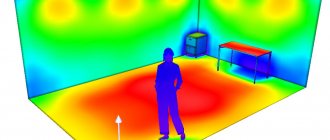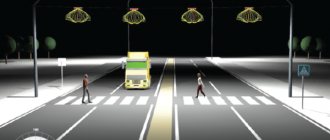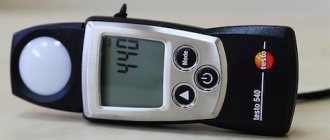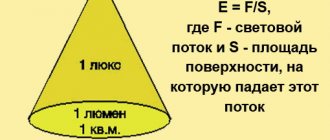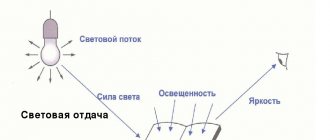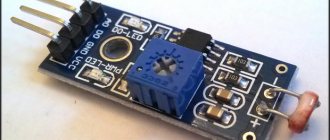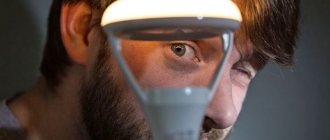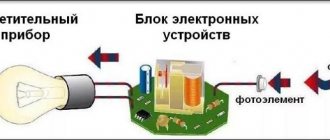Dec 28 • Development and design, Articles • •
(
104 votes, average: 4.87 out of 5)
Illumination pulsations: problems, metrology and calculation. Modern lighting systems have many advantages over outdated incandescent lamps and even gas-discharge lamps, among which are high energy efficiency, long service life, low maintenance costs , wider and new areas of application and much more. Therefore, the transition to modern energy-saving lighting is inevitable. However, modern lighting systems at the present stage have their own disadvantages - firstly, a relatively high price, lack of experience in proper use, a large proportion of low-quality products, and non-compliance of the parameters of light sources with current standards. Very often, as practice shows, our clients are faced with the problem of increased pulsations of light flux and the resulting pulsation of illumination.
Published in Lumen&ExpertUnion magazine No. 3/2013
Sergey Mamaev, technical director of Eco-Sphere LLC. Graduated in 1996. Moscow Engineering Physics Institute with a degree in Microelectronics. 1993-2008 - leading developer and technical director of the instrument-making company, since 2008 co-founder and technical director of the instrument-making company. Participation in the development and serial production of more than 20 measuring instruments and automation systems.
Light pulsations and their effect on the human body
We will consider the requirements of regulatory documents for the level of illumination pulsation a little later. First, I would like to briefly touch upon the problem of the influence of light pulsations on the human body. Unfortunately, many lighting manufacturers and lighting engineers view these requirements as a needless irritation that makes their lives more difficult. However, studies of the effects of pulsating light on the human body, which have been carried out since the mid-twentieth century, have shown, in particular, that the human brain perceives light pulsations with a frequency of up to 300 Hz. For example, in [1] the EEG of the human brain is given (Fig. 1), which shows that when exposed to pulsating light, imposed peaks of activity appear on the EEG of the brain at the frequency of the light pulsation. These imposed rhythms suppress the natural biorhythms of the nervous system (in this example, the frequency of light pulsations was 120 Hz).
Rice. 1. EEG of the human brain in a darkened room (a), EEG of the human brain in a room illuminated by lamps with a pulsation frequency of the light flux of 120 Hz
During the same experiments, it was found that at a level of light pulsations of 5-8%, signs of a disorder in the normal electrical activity of the brain already appear, and pulsations with a depth of 20% cause the same level of disturbances in the normal activity of the brain as light pulsations with a depth of 100 %. The critical frequency of light pulsations was also determined to be 300 Hz, above which the human body perceives pulsating light as constant. Similar results were obtained in [2]. It should be noted that visible (frequency up to 60...80 Hz) and invisible to the eye (from 60...80 Hz and up to 300 Hz) light pulsations have different (visual and non-visual) effects.
Light pulsations visible to the eye cause direct visual irritation, we feel them, they cause discomfort, tire our vision, nervous system and brain. However, we see them and try, consciously or at the subconscious level, to fight them - to limit the time spent in rooms with pulsating light, reflexively adjust our vision and brain to limit the influence of such pulsations, and in the end we change the lamp or lamp that irritates us to another one with no pulsations . Thus, we feel the harm or at least discomfort from visible pulsations well and, to the extent possible, fight them.
Starting from frequencies of 60-80 Hz (depending on the individual characteristics of a person), we cease to visually feel the impact of light pulsations - we do not see them. This frequency is called the critical flicker fusion frequency (CFMF). That is, our brain does not have time to process incoming information about changes in the intensity of the light flux. However, these light pulsations are detected by visual receptors, but are not processed as visual information and directly affect the functioning of other parts of the brain. Ultimately, high-frequency light pulsations affect a person’s hormonal levels, daily biorhythms and associated performance, fatigue, and emotional well-being.
With prolonged exposure to pulsating light levels, they can lead to chronic diseases not only of the visual organs, but also of the cardiovascular and nervous systems. That is, we see that the requirements for the level of lighting pulsations did not arise out of nowhere and long before the advent of modern light sources.
The problem of lack of serious control over the level of lighting pulsations is constantly raised by Russian doctors [3]. Constant work is underway to develop modern lighting quality standards.
Negative impact
Visible pulsations of light flux with a frequency of up to 80 Hz have a negative effect on the brain and irritate the nervous system through the organs of vision. As a result, a person is subconsciously forced to deal with discomfort and wants to quickly leave the area affected by the flickering light. Pulsating light can also lead to actual work-related injuries. For example, if the rotation speed of a circular saw matches the frequency of the luminous flux of an LED lamp, it may seem to a person that the machine is not moving. Situations like these are serious causes of workplace injuries. Flicker in the range of 80–300 Hz is not directly perceptible to the human eye. However, visual receptors detect these vibrations, which provoke disruptions in the functioning of the brain. Acting unnoticed, they gradually shift hormonal levels, contribute to a decrease in performance, and worsen emotional well-being. As experiments have shown, prolonged exposure to light flux pulsations contributes to the emergence and exacerbation of chronic diseases of the nervous system.
Regulatory requirements for the level of light pulsation
Requirements for the level of pulsation of artificial lighting are scattered across various regulatory documents. Here are excerpts from some:
1. SNiP 23-05-95 “Natural and artificial lighting” states that the pulsation coefficient of illumination of the working surface of the workplace should not exceed 10% - 20% (depending on the degree of work intensity), while only those pulsations, frequency which are below 300 Hz. 2. In GOST 17677-82 “Lamps. General Technical Conditions" provides requirements for the operating frequency of ballasts (ballasts) of lamps with fluorescent lamps. It should be at least 400 Hz. 3. SanPiN 2.2.2/2.4.1340-03 “Hygienic requirements for personal electronic computers and organization of work” states that the lighting pulsation coefficient when working on a PC should not exceed 5%.
So, we can generalize that illumination pulsations, with a frequency of up to 300 Hz, in workplaces should not exceed 20%, and in some cases (when working with a PC) - 5%. In places of temporary stay (corridors, stairs, passages, etc.) the pulsation level is not standardized. Also, illumination pulsations, the frequency of which exceeds 300 Hz, are not standardized.
On January 1, 2013, the new GOST R 54945-2012 “Buildings and structures” came into force. Methods for measuring the pulsation coefficient of illumination.” This document finally clearly spells out all the formulations, methods for measuring and calculating illumination pulsations.
Ways to reduce lighting pulsation
There may be several solutions to this. It all depends on the characteristics of the room and the type of devices used; the following methods are most often used:
- Connecting lamps to a two- or three-phase line alternately. Due to the shift, the voltage is applied unevenly and flicker is reduced.
- When powered from a three-phase line, the number of lamps must be a multiple of three, and when powered from a two-phase line, the number must be a multiple of two.
- Replacement of outdated equipment with modern LED equipment.
- Use of fluorescent lamps with a modern power supply of 5 kHz or higher.
The video discusses the impact of light pulsations on the safety of road users.
It is necessary to control the pulsation of lighting. It affects the comfort of a person’s stay, his fatigue, and in industrial premises safety depends on this indicator.
Illumination pulsations: calculation of luminous flux pulsations
According to GOST R 54945-2012, the level of illumination pulsation is characterized by the pulsation coefficient (Kp). It represents the ratio of the difference between the maximum and maximum illuminance values to the average illuminance value over the measurement time.
F. 1. Formula for calculating the pulsation coefficient according to GOST R 54945-2012
where Emin is the recorded minimum illumination value (see Fig. 2), Emax is the recorded maximum illumination value (see Fig. 2), Esr is the average illumination value during the measurement time (see Fig. 2)
Rice. 2. Graphic representation of light flux pulsation parameters
According to GOST R 54945-2012, it is necessary to take the integral value of illumination as Ecp. Then the complete formula for calculating the pulsation coefficient is:
F. 2. Formula for calculating the pulsation coefficient according to GOST R 54945-2012
where T is the measurement time. However, until recently, to calculate the pulsation coefficient, the arithmetic mean value was often used as Ecp:
F. 3. Formula for calculating Eсr
then the formula for calculating illumination pulsations takes the form:
F. 4. Complete formula for calculating the illumination pulsation coefficient
Preface
The goals, basic principles and general rules for carrying out work on interstate standardization are established by GOST 1.0 “Interstate standardization system. Basic provisions" and GOST 1.2 "Interstate standardization system. Interstate standards, rules and recommendations for interstate standardization. Rules for the development, adoption, updating and implementation of the Research Institute of Building Physics of the Russian Academy of Architecture and Construction Sciences (FGBU NIISF RAASN) and the Limited Liability Company CERES-EXPERT with the participation of the Federal State Unitary Enterprise All-Russian Research Institute of Optical -physical research" (FSUE "VNIIOFI"), Limited Liability Company "Archilight", Limited Liability Company "Research Institute of Labor Protection in Ivanovo"
2 INTRODUCED by the Technical Committee for Standardization TC 465 “Construction”
3 ADOPTED by the Interstate Council for Standardization, Metrology and Certification (protocol dated November 12, 2015 N 82-P)
The following voted for adoption:
| Short name of the country according to MK (ISO 3166) 004-97 | Country code according to MK (ISO 3166) 004-97 | Abbreviated name of the national standardization body |
| Kyrgyzstan | KG | Kyrgyzstandard |
| Russia | RU | Rosstandart |
| Tajikistan | T.J. | Tajikstandard |
4 By Order of the Federal Agency for Technical Regulation and Metrology dated November 30, 2015 N 2079-st, the interstate standard GOST 33393-2015 was put into effect as a national standard of the Russian Federation from January 1, 2022.
5 INTRODUCED FOR THE FIRST TIME
6 REPUBLICATION. November 2022
Information on the entry into force (termination) of this standard and amendments to it on the territory of the above states is published in the indexes of national standards published in these states, as well as on the Internet on the websites of the relevant national standardization bodies.
In case of revision, modification or cancellation of this standard, the relevant information will be published on the official website of the Interstate Council for Standardization, Metrology and Certification in the catalog “Interstate Standards”
Features of calculating the pulsation coefficient
When measuring signals with a shape close to harmonic, the result of calculating the ripple coefficient using formulas (2) and (4) is almost identical. However, when calculating the ripple coefficient of pulse signals, the results of calculations using formulas (2) and (4) can differ greatly. In particular, it is clear that when calculating using formula (4), the value of Kp can never exceed 100%, while when calculating using formula (2), with large signal duty cycles, it can significantly exceed 100% or more.
Figure 3 shows an example of measuring the brightness pulsation coefficient of a CRT monitor screen using the FG-01 photo head and the EcoLight-AP program. The difference in several times between the values of Kp = 92.4%, calculated by formula (4), and Ki = 258.5%, calculated by formula (2) is clearly visible.
Rice. 3. Measuring the flicker of a CRT monitor
This calculation feature must be remembered when measuring the ripple coefficient of lighting sources controlled by pulse converters or power supplies (for example, dimmers). And in general, the use of low-frequency pulse converters (with a conversion frequency of 300 Hz and below) and thyristor regulators with phase power control (power control by turning on the load for only part of the period of alternating mains voltage) should be avoided for lighting control.
Efficiency
The main characteristic of any energy device is its efficiency, which is equal to the ratio of active powers at the output (Pout) and at the input (P - power consumed from the primary network):
where
Pout
=
P
=
U
×
I
- output power.
If the primary network is DC, then the power consumption is determined by P = UВХ×IВХ.
If the primary network is AC, then the power consumed from the network at harmonic current is equal to: S = U×I
- apparent power
P = U×I
×cos
φ
- active power
Q = U×I×
sin
φ
- reactive power, where
U , I
- effective values of voltage and current.
The power triangle is valid (Figure 1):
If the consumption current is non-sinusoidal, then active power is consumed only at the frequency that coincides with the frequency of the network voltage. Here, in full power, another term appears - distortion power (T)
but active power is consumed only by the first harmonic P=U×I1×cos φ1, where I1 is the effective value of the first harmonic of the current and the shift angle of this harmonic is φ1.
Light Ripple Coefficient Measurements
Today, on the Internet on various thematic resources, various methods for determining the pulsation of light flux from any sources are actively discussed. Starting from the “pencil method”, using digital photo and video cameras and ending with a photodiode connected to an oscilloscope. We will not delve into the description and comparison of all available methods (this is a topic, rather, for various forums and blogs), but, in our firm conviction, none of these methods gives at least a minimum guarantee that you can at least “catch” the pulsation, not to mention measuring the pulsation coefficient.
To measure light pulsations, specialized devices are produced in the Russian Federation - pulse meters. In particular, the function of measuring the coefficient of illumination pulsation is built into the luxmeters-brightness meters-pulsemeters "EcoLight" (Fig. 4, 5), some of the devices TKA PKM (Fig. 6.), "Argus-07" (Fig. 7).
These are professional devices developed taking into account the requirements of regulatory documents of the Russian Federation. They are included in the State Register of Measuring Instruments of the Russian Federation and can be supplied with metrological verification. The price of such devices ranges from 18,000 rubles and above. There are no serious foreign instruments for measuring pulsations of light flux on the Russian market. Unfortunately, until recently, inexpensive heart rate monitors were completely absent from the market. However, since mid-2014, an inexpensive personal lux meter-pulse meter-brightness meter “Lupin” (Fig. 8.) has been on sale, similar in its parameters to professional devices, but at a significantly lower price.
Lupine
For a deeper analysis of pulsations - their nature, shape, frequency components, maximum, minimum values, calculation of the pulsation coefficient by two different methods (see above), you can use the free EcoLight-AP program. It works with professional devices of the Ecolight series and the personal luxmeter-pulsemeter-brightness meter "Lupin". Some results of pulsation measurements obtained using the EcoLight-AP program are shown in Fig. 9, 10, 11.
How to remove pulsation in an LED lamp
LED lights may flicker both when off and on.
There are only three reasons:
- faulty electrical wiring;
- incorrect setting of the backlit switch;
- simplified driver diagram.
Diodes are negatively affected by old aluminum wiring if the wires are connected incorrectly or the insulation material has aged. When screwing in an incandescent LED light bulb with a base, there is always a phase present on the power supply. Due to the high sensitivity of the driver, current is supplied to it, which flows through the old insulation to the ground. Therefore, the LED lamp receives a small current, which is enough to charge the capacitor. The accumulated potential is periodically applied to the lamp.
If, after testing the circuit, it turns out that the wires and switch are connected correctly, the only correct solution is to replace the aluminum wiring with copper.
Attention! If powerful electrical appliances (warm floors, electric stove, boiler, heating boiler) are connected to the electrical network in a house or apartment, a magnetic field is created in the wiring. When lighting wires are placed nearby, induced voltage is generated, causing flickering.
If the backlit switch is not changed after replacing the lamp, the currents passing through it accumulate in the driver, charging the capacitor. When discharging, current flows from it to the LED lamp. To fix the problem, you should remove or improve the backlight. When choosing the second option, it is necessary to install a capacitor or resistor between the neutral and phase wires.
Important! If there are several LED bulbs in the lamp, you need to screw an incandescent lamp into one socket, which will act as a shunt.
If an LED lamp has a low-quality driver, it cannot provide a stable current at the pn junction. Cheap blocks divide the voltage into a sinusoid and smooth out ripples. They consist of a film and electrolytic capacitor, resistors connected in parallel to the circuit, and a diode bridge. As a result, an unstable current is produced, and the LED flickers and oscillates.
The only solution is to replace the electrolytic capacitor with an element with a higher resistance. But most often it does not fit in size. In addition, you need to remove the board from the LED lamp, find the capacitor, be able to unsolder it and solder another one.
Attention! The only correct solution is to replace the driver or buy a better light bulb.
In areas where the supplier uses outdated transformer equipment to supply electricity, the voltage on the line decreases. This negatively affects the operation of LED lamps. A current stabilizer solves the problem.
Illumination pulsations of modern lamps and luminaires: measurement experience
In our practice, there are many examples of successful and unsuccessful use of new lighting systems. From the real-life examples below it is clearly seen that modern lighting technologies are still in their infancy. And therefore, there are a large number of either not quite “mature” solutions on the market, or often outright fakes or defects. At the same time, we see that all these problems can be solved, especially if, before implementing a lighting project, careful work is done to calculate and test the proposed solution and localize or eliminate potential problems in advance.
For example, the presence of pulsations in a lamp or lamp, as a rule, indicates that the manufacturer may have decided to save on production, because maintaining low ripple requires some small additional cost on his part. And it's fair to assume that if a manufacturer skimped a little on ripple suppression, they likely could have skimped on other components, which could result in poor lamp or luminaire performance such as life, color rendering, energy efficiency, electromagnetic compatibility, protection from overloads and voltage surges in the network and much more...
Here are just a few real-life examples of measuring ripple levels, what causes them, and how to combat them.
1. Moscow Engineering Physics Institute (MEPhI). Widespread replacement of outdated lamps using LB-40 and EMPRA lamps (pulsation coefficient about 40%) with LED lamps of the Armstrong type. After replacement, the pulsation coefficient increased to 56%, and after just six months of operation, individual cases of lamp failure were noted. Studying the circuit of the new lamp showed the complete absence of any control circuit. A single LED line of 42 series-connected LEDs is powered from the output of a step-down transformer through a diode bridge and a filter capacitor of minimal capacity.
2. A supplier of “smart” expensive lighting systems from a well-known foreign brand asked about increased pulsations of the luminous flux of the lamps it supplied at intermediate brightness levels. Measurements using the EcoLight-AP program showed that the brightness of the lamp is controlled by a PWM modulator with an operating frequency of about 200 Hz. The manufacturer was sent measurement results, based on which the operating frequency of the PWM controller was increased to 1 kHz. As a result, luminaire pulsations were reduced to less than 1% at all brightness levels.
3. Ceiling lamps of the “Armstrong” type with “noname” gas-discharge lamps 4 * 18 W and EMF. The illumination at the control point is 450 lux, the illumination pulsation coefficient is 40%. The lamps were replaced with new ones with a color rendering index Ra > 90 and the electronic ballasts were replaced with high-quality electronic ballasts of class A2. With the same power consumption, we obtained a light pulsation value of less than 0.5% and an increase in illumination at the control point to 1100 lux. The cost of modernization is minimal - about 130 rubles per lamp and about 500 rubles for electronic ballasts. Total, about 1000 rubles for one lamp.
Unit
Illumination is the luminous value that is equal to the flux of light incident on a surface to its area. It is considered directly proportional to the light source. Differs in uniform distribution on the area. It is found by dividing the candela luminous intensity by the distance to the light source and multiplied by the cosine of the angle of incidence of the sun's rays.
Note! It is measured according to the international classification system in lux, which is equal to ten photos or one lumen per square meter. Therefore, the unit of illumination measurement is lux
It is worth noting that it can be converted to candela and watt.
Basic unit of measurement lux
Candela
Candela, translated from English as candle, is a unit of measurement of the intensity of a light source according to the International Unit System. It was formed in 1979. Equal to 540⋅1012 Hz or 683 lm/W. Various light sources are measured in candelas, for example, an incandescent lamp with a candle, a super-bright LED, a fluorescent lamp and the sun. Addition: the approximate solar power in candelas is 2.8⋅10, which translates into watts of 3.83⋅1026
Candela
Lumens and Luxes
A lumen is a unit of measurement that is equal to the flux of sunlight emitted by a source, equal to a candela and a steradian. The entire light flux is measured in lumens, but the calculation does not take into account the strength of the lens with reflectors, so the resulting indicator is not a direct parameter for assessing the brightness with the efficiency of the source.
Lux is the SI measuring subunit of lumen. Unlike lumen, lux gives an estimate of the luminous flux that falls per square meter. The same gives an understanding of what luminous flux the light source has.
Note! That is, lux is a characteristic that allows you to find out the efficiency of a lamp in a specific area. To better understand their main difference, it is worth considering the figure
It clearly shows how as the height increases, the lighting expands and how the brightness decreases
To better understand their main difference, it is worth considering the figure. It clearly shows how as the height increases, the illumination expands and how the brightness decreases.
Lumen and lux as a measurement unit
Lumen and Watt
As stated above, a lumen is the full amount of light from a light source. Watt is an indicator of how much power, heat flux, sound energy and total power of electric current or radiation a device has. One watt equals 100 lumens. The translation can be done independently using special formulas or with the assistance of calculators. Often all the necessary indicators are given on the device itself.
It is worth noting that modern LEDs have the best performance. They have high brightness, harmonious spectral distribution, durability, and resistance to various types of influences. Interestingly, if we take devices with the same illumination, they will consume ten times less electrical energy than incandescent lamps.
Note! Considering the actual service life and reduced operating investment costs, the purchase of these products will be economically feasible. Converting lumens to watts
Converting lumens to watts
Multiples of units
For convenience, lumen units are disassembled into parts. So, there are kilolumens, megalumens and gigalumens. There are 1000 lumens in one kilolumen, 1000000 in a megalumen, and 1000000000 in a gigalumen. There are also other quantities with the prefixes deca, hecto, tera, peta, exa, zetta and iotta.
Submultiple units
The same approach applies to submultiple values. The basic ones are millilumens, microlumens and nanolumens, which are equal to 10 to the −3 power, 10 to the minus 6 power and 10 to the minus 9 power. There are also the prefixes deci, santi, pico, femto, atto, zepto and iokto. It is worth noting that submultiples, as well as multiples, are used only in professional settings and when performing physical tasks. In real life, illumination measures and other parameters are not used for calculations.
Causes of the stroboscopic effect
The stroboscopic effect is a phenomenon of distortion of the perception of moving or rotating elements of equipment. This can often be seen on the pulley of a rotating lathe, under certain conditions creating the illusion that it is stationary or rotating in the opposite direction. This phenomenon is observed in cases where the frequency of the alternating current supplying the device is a multiple of the rotational speed of the device or mechanism.
Most often, this phenomenon can be observed in industrial premises illuminated by fluorescent lamps. In fact, due to the variable power supply, it turns out that the period of turning the lamp on and off overlaps the rotation speed of the mechanism.
For safety reasons, all production areas were previously lit with incandescent lamps as they have a much lower flicker rate, minimizing the risk of strobing. In modern conditions, LED lamps have become the best solution, but only if high-quality equipment with DC power supplies is used.
An example of the strobe effect of low-quality LED lamps.
